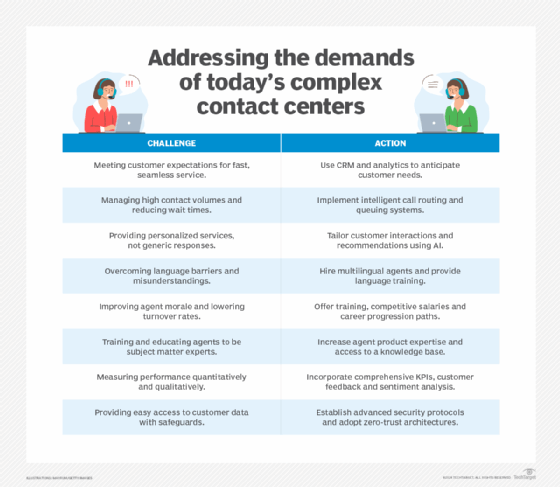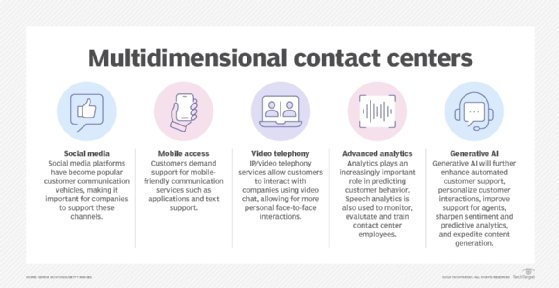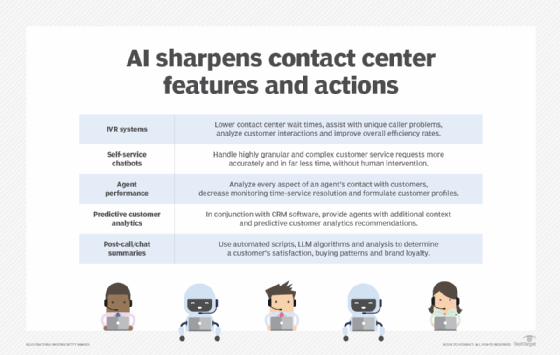How to improve the contact center experience for customers
Customers want their contact center interactions to be fast, seamless, tailored and personal in the form of mobile apps, self-service, improved IVR and knowledgeable human agents.
Customer service at many large and small businesses can be an exercise in frustration for customers stuck in an endless loop of automated menus and long wait times. On the flip side, businesses that answer customer questions, resolve problems quickly and improve the overall customer experience get noticed in a positive way and gain a competitive edge.
One-dimensional call centers with predefined dialogues and guidelines used by customer service representatives -- often located at business processing centers in India -- are being supplanted by multichannel contact centers that support voice services, mobile apps, interactive voice response (IVR) systems, live chats, SMS, texting, chatbots, email, social media, video and websites.
Businesses like Nordstrom and Zappos use a customer-first approach. Others like Amazon invest in AI and automation to support an omnichannel strategy. These enterprises offer a positive contact center experience by providing accessible information and customer support 24/7. They also focus on customer service metrics, agent training and incentives to improve response times, resolution quality and personalization.
What is the contact center experience?
In its simplest terms, the contact center experience is how customers perceive quality of service when they interact with a company's support systems through multiple communication channels. These interactions can include placing a live phone call to a member of the customer service team or using the customer self-service (CSS) capabilities in the company's mobile app. It all depends on the communication technologies and other touchpoints supported by the contact center's purpose. Contact centers could be dedicated to inbound customer service and support, outbound sales and marketing, multichannel support or omnichannel communications.

For high performance contact centers and their teams, consistency and service quality across channels remain critical for customer satisfaction. Positive customer experiences can yield a higher customer satisfaction score for products and services, brand loyalty, word of mouth advertising and promotion of a company's product on social media instead of damaging customer feedback.
Many queries still start in voice or are escalated to voice to resolve customer issues. The general wisdom that older generations prefer phone calls while younger people use digital communications to interact with customer support didn't hold true in a McKinsey & Company May 2023 "Customer Service Survey" of 3,500 consumers. McKinsey found that 71% of 18- to 28-year-olds reported they're likely to call a business to resolve problems that can't be addressed using CSS options. They also expect a higher level of live phone support, especially in premium service segments, such as financial services.
"Talk of the demise of the contact center due to the rise of automation and armies of service bots may be, it seems, overdone, or at least an oversimplistic take," wrote Brian Blackader, a partner at McKinsey, in an April blog about the research findings. "Instead, the phone will remain a prominent communication channel, with those able to find the right mix of human and machine positioned to lead."
Customers from all generational demographics accepted live chat, messaging and email as important for customer service communication. Email offers convenience to consumers, according to researchers, but even with email response management systems, it's harder for companies to analyze and measure results.

Importance of a good contact center experience
Creating a successful contact center experience is all about meeting the needs of customers. It's important to monitor changes in customers' behaviors to advance channel strategies, instead of focusing solely on technology trends.
Consumers are understandably turned off when they encounter barriers to reaching a contact center agent. In fact, more than half of 5,728 consumers surveyed by Gartner indicated they would consider switching to a competitor if a customer service organization planned to use AI during interactions. The top concern acknowledged by 60% of consumers surveyed is "it will become more difficult to reach a person," while 42% said "AI will provide the wrong answers."
Most customers have some level of familiarity with AI, noted Christopher Sladdin, director analyst for Gartner service and support. They've used OpenAI's ChatGPT or similar tools to find information for their service and support issues, but, Sladdin added, they have concerns about a company's use of AI for customer service.
Customers are also migrating from traditional search engines to other media platforms. Google is still the No. 1 third-party tool, but customers are increasingly using YouTube and other platforms such as Reddit and TikTok to find user-generated content to help resolve their issues. Businesses, therefore, should consider adjusting their media strategies to support brand ambassadors and monitor content on these platforms. "We've found that customers find that third-party content is just as trustworthy as content from a customer service center," Sladdin reported.

Improving the contact center experience
Businesses need to think about their customers' willingness to use new customer service and support tools in their contact center, along with the readiness of the internal organization to implement them. In addition to a significant investment in AI technologies, companies will have to consider integration with legacy systems, training for contact center agents and potential legal risks.
Investment and wider adoption of technologies such as generative AI by many businesses could take years. Meanwhile, some high-profile missteps have shown the potential downsides. The British Columbia Civil Resolution Tribunal, for example, found in favor of an Air Canada passenger, who claimed that an AI chatbot provided inaccurate information regarding the airline's discount policy on bereavement fares. The passenger used a screenshot of the text interaction to prove to the court that the chatbot hallucinated by claiming the passenger had 90 days after travel to receive the bereavement discount, when in fact the airline's discount policy doesn't allow for refunds after travel has already occurred. Even though the AI chatbot provided a link to the correct policy, the court awarded the plaintiff a refund and court fees.
Businesses will have to build trust around the use of generative AI and what to disclose to customers. The EU's Artificial Intelligence Act, which takes effect in August 2024, with most of its provisions coming into operation by 2026, requires users to be informed that they're interacting with a machine. That level of transparency is not yet mandated in the United States.
Gartner research shows that customers who start by using CSS options, even if they require assistance to resolve an issue, are more likely to use self-service in the future. Mobile apps and IVR present opportunities to create better CSS options.
Generally, the cost per contact to service a customer issue is a lot cheaper with CSS than if a human agent is involved. The key is to get customers to adopt those tools. "The problem is the containment challenge," said Sladdin. "We're not great at keeping people in their channel and actually being able to address their issue." Once they switch channels, the cost increases.
Consumers who started their customer journey in a mobile app, according to Gartner, reported the highest self-service success rate, followed in descending order by online account portals, customer community forums, online request form, social media, chatbot or virtual customer assistant, and websites (FAQs or help articles). Moreover, more than two-thirds of customers who used the mobile app for customer service reported the highest level of customer satisfaction.
Research further showed that IVR is underutilized by companies as a self-service option. These systems can support inbound IVR for customer-initiated calls, and in some cases, outbound IVR for marketing and sales. While 54% of those surveyed used the phone for problem resolution, just 14% attempted to use IVR with little success, prompting Gartner to suggest that investments in better IVR systems may increase self-service success.

AI's influence on the contact center experience
The transition from on-premises to cloud-based contact centers has accelerated over the past few years. Businesses are investing in new platforms and tools to increase operational efficiency and customer personalization. Adoption of contact center as a service (CCaaS) and other technologies like CRM and workforce management that support multichannel interactions has intensified, along with executive and board-level scrutiny.
Contact center agents handle customer communications across multiple channels, often fielding phone calls, text messaging, email and social media. These roles require knowledge of technology in addition to listening, problem solving and oral communication skills. Customer interaction data is sometimes siloed and not easy to access across channels. If a problem isn't addressed in one channel, the customer must repeatedly make the same requests, leading to customer and agent frustration.
Many companies want to automate a large percentage of agent workflows and move repetitive tasks and customer conversations to generative AI and virtual agents. Cloud providers with large-scale data centers, such as Amazon, Google and Microsoft, are developing AI platforms. Amazon Bedrock, Google Cloud Vertex AI and Microsoft Azure OpenAI work with their respective CCaaS technologies as well as third-party platforms.
Amazon upgraded its CCaaS platform, Amazon Connect, with some generative AI functionality. Generative AI virtual assistant Amazon Q, for example, is designed to understand customer intent through voice and text interactions and can suggest next actions to contact center agents. The agents can also use the AI virtual assistant to ask questions in Amazon Connect and respond to customer inquiries without searching multiple data sources. The AI technology can summarize customer contact information and help unify information in Amazon Connect Customer Profiles, including data from third-party software such as Salesforce and Adobe Analytics.
"A lot of executives see AI as the golden ticket item for customer service," Sladdin said. "There's a common belief that it may finally reduce the headcount in the contact center. That's not really reality."
While AI and other tools have the potential to reduce agent headcounts in the long term, there's very little evidence of reductions. Customers still need the reassurance and connection provided by human agents.
Kathleen Richards is a freelance journalist and industry veteran. She's a former features editor for TechTarget's Information Security magazine.







